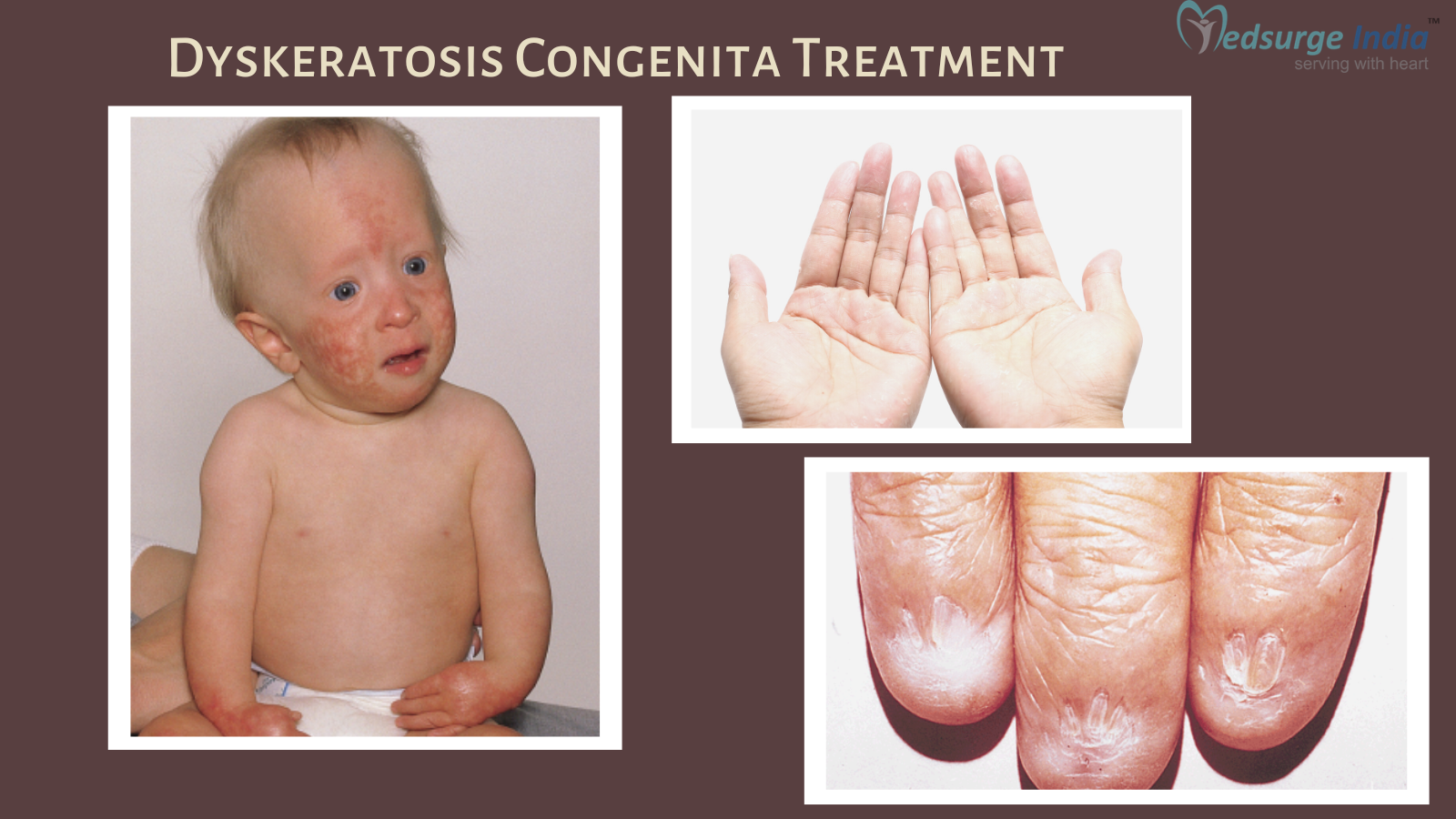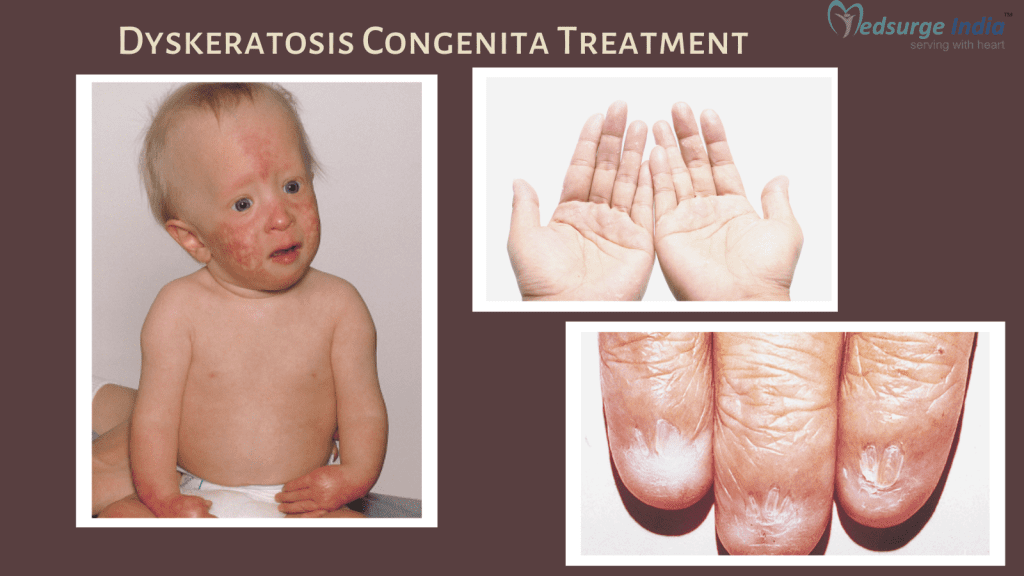Dyskeratosis Congenita Treatment Cost in India
Unlock Exclusive Discount : Your Gateway to Premium Healthcare with Medsurge India Health Value Card.

Unlock Exclusive Discount : Your Gateway to Premium Healthcare with Medsurge India Health Value Card.



Dyskeratosis congenita (DKC) is a progressive congenital bone marrow failure syndrome characterized by low levels of RBCs, WBCs, and platelets, as well as skin and nail changes. The Dyskeratosis congenita treatment in India can be done with hematopoietic bone marrow transplantation. The best doctor to see is a highly qualified oncologist specializing in diagnosing and treating DKC.
The cost of Dyskeratosis congenita treatment in India is quite low. According to reports, the 10-year survival rate following DKC diagnosis and treatment in India is around 25%. DKC symptoms include skin hyperpigmentation, nail dystrophy, and leukoplakia, which appear as white patches inside the mouth.
Dyskeratosis congenita is a disorder that impacts many different parts of the body. This disorder is distinguished by three characteristics: Nail dystrophy refers to poor growth or abnormally shaped fingernails and toes; changes in skin coloring (pigmentation), particularly on the neck and chest, in a pattern commonly described as “lacy”; and white patches inside the mouth (oral leukoplakia).
People with dyskeratosis congenita are more likely to develop a number of life-threatening conditions. They are particularly vulnerable to conditions that impair bone marrow function. These diseases impair the bone marrow’s ability to produce new blood cells.
Aplastic anemia, also known as bone marrow failure, occurs when the bone marrow does not produce enough new blood cells in affected individuals. They are also more likely than the general population to develop the myelodysplastic syndrome, a condition in which immature blood cells fail to develop normally; this condition can progress to leukemia, a type of blood cancer.
DC can also cause pulmonary fibrosis, a condition in which scar tissue accumulates in the lungs, reducing the flow of oxygen into the bloodstream.
Although congenital (present at birth), the signs and symptoms of DC may not appear until late childhood or early adolescence, and in some cases not until adulthood.
DC in its traditional form is rare, affecting about one person in a million, but the broader spectrum of telomere disease may affect 10 to 100 times as many people.
The first symptoms of dyskeratosis congenita generally appear in childhood. Almost any part of the body can be affected by the disease. It is most commonly seen in cells that reproduce quickly, such as skin, nails, and mucous membranes.
Your child could have:
On average, Dyskeratosis Congenita Treatment Cost in India starts from USD 3,000. Here are the estimated prices depending on different cities in India.
| Cities | Starting Price |
| Delhi | USD 3,000 |
| Gurgaon | USD 3,000 |
| Noida | USD 3,000 |
| Mumbai | USD 3,200 |
| Hyderabad | USD 3,000 |
| Chennai | USD 3,000 |
| Kolkata | USD 3,000 |
| Bangalore | USD 3,000 |
Please keep in mind that prices of Dyskeratosis Congenita Treatment Cost in India will vary depending on various factors.
The following here are some variables that can affect Dyskeratosis Congenita Treatment Cost in India:
The standard and grade of medical care and amenities are comparable to those of the most prestigious healthcare facilities in the world, even when the expense of lodging, meals, and transportation is taken out. Under the direction of the most skilled physicians, Medsurge India provides patients with the lowest Dyskeratosis Congenita Treatment Cost in India.
Doctors frequently struggle to diagnose dyskeratosis congenita because people possess unique symptoms at different stages of their lives (DC). If a clinical evaluation and detailed family history indicate that the condition is suspected, your doctor may order some or all of the following tests:
Helpful – Bone Marrow Transplant Cost in India
There is currently no cure for dyskeratosis congenita. Treatment focuses on preserving bone marrow function, as this is the leading cause of death:
A hematologist will be referred to you by your child's provider. This is a blood disorder specialist. There is currently no cure for the condition. It is essential to keep an eye out for signs and symptoms of bone marrow failure in your child. Certain symptoms of the disease may be treatable by your child's healthcare provider.
An anabolic steroid may be prescribed for those who have bone marrow failure. It resembles the male hormone testosterone. The medication stimulates the production of new cells in the bone marrow. Stem cell transplants may be used to treat bone marrow failure. However, stem cell transplants carry a high risk of death in people with dyskeratosis congenita.
There are numerous serious complications, such as:
Dyskeratosis congenita affects each patient differently. Some people with DC have normal bone marrow function and only a few mild physical symptoms. Others are more severely affected and develop bone marrow failure, cancer, or pulmonary fibrosis by early adulthood. In general, the effects of dyskeratosis congenita worsen with age.
Although there is no cure, children who receive early treatment for dyskeratosis congenita may have a higher quality of life. Early detection of problems such as cancer can lead to faster treatment and better outcomes.
A: Mutations in the TERT, TERC, DKC1, or TINF2 genes cause dyskeratosis congenita in roughly half of the people. These genes encode proteins that aid in the maintenance of structures known as telomeres, which are found at the ends of chromosomes.
A: In most cases, dyskeratosis congenita is inherited. The inheritance pattern can be X-linked (Zinsser-Cole-Engleman syndrome), autosomal dominant (Scoggins type dyskeratosis), or autosomal recessive.
A: When the bone marrow is unable to produce enough healthy blood cells to meet an individual's needs, this is referred to as bone marrow failure. The bone marrow is the soft, spongy center of the bones that serve as the body's factory, producing all blood cells. Red blood cells, for example, transport oxygen throughout the body.
A: In general, the effects of dyskeratosis congenita worsen as a person ages. Although there is no cure, children who receive dyskeratosis congenita treatment early in life may have a better quality of life. Early detection of problems such as cancer can result in faster treatment and better outcomes.
A: A complete blood count (CBC) is a common blood test that your doctor may advise you to have if you: Aid in the diagnosis of certain blood cancers, such as leukaemia and lymphoma. Determine whether the cancer has spread to the bone marrow. Examine how a person's body responds to cancer treatment.
By using our site, you agree to our Terms and Conditions, Privacy Policy and Refund Policy. Medsurgeindia does not provide medical advice, diagnosis, or treatment. The information provided on this site is designed to support, not replace, the relationship that exists between a patient/site visitor and his/her existing physician. We also Accept International Payments.

Copyright © 2025 NSM ONLINE SOLUTIONS PRIVATE LIMITED. All rights reserved.